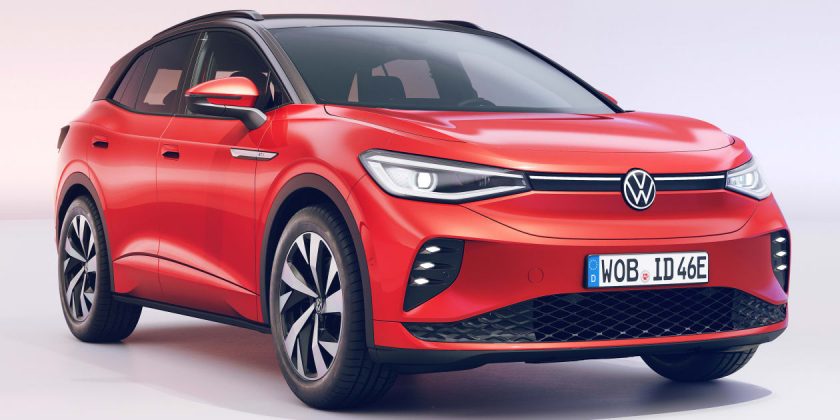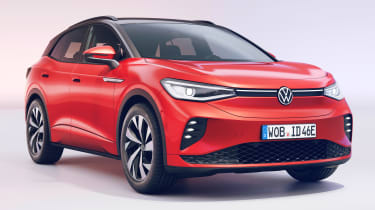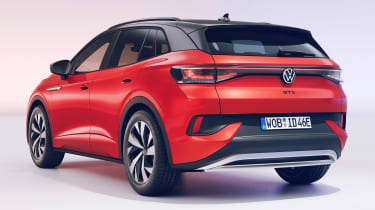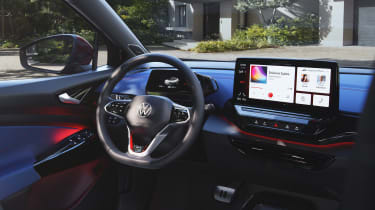The new Volkswagen ID.4 GTX electric SUV has a maximum range of 298 miles and a 0–62mph time of 6.2 seconds
Volkswagen has launched a performance version of the ID.4 electric SUV, which is the first model in the brand’s line-up to wear a new badge: GTX – an electric equivalent to GTI.
The Volkswagen ID.4 GTX is on sale in Germany now priced from €50,415 (around £43,500), although that includes a €7,500 subsidy from the German government. Either way, when it reaches the UK market later this year, it won’t be eligible for the government’s recently revised £2,500 plug-in grant.
New Volkswagen ID.4 2021 review
Like the standard ID.4, the GTX is based on the Volkswagen Group’s MEB underpinnings, although the standard car’s rear-mounted 201bhp electric motor is now supported by an extra motor for the front axle, to deliver a combined output of 295bhp.
Volkswagen says the system has enough grunt for a 0–62mph time of 6.2 seconds, which is about the same as the current Golf GTI. However, due to the mechanical limitations of the powertrain (and Volkswagen’s desire to maximise the ID.4’s battery life), the GTX’s top speed is capped at 112mph.
Under normal driving conditions, the ID.4 GTX is propelled by the rear electric motor alone. However, when the car recognises a loss of traction or a demand for more power through the accelerator, it activates the front motor to keep the SUV planted or accelerating as fast as it can.
To support the more powerful electric motors, the ID.4 GTX is available with an optional Sports package, which adds lowered sports suspension and progressive steering – the latter altering the steering ratio according to the amount of steering lock applied. Volkswagen’s optional Sports Plus package builds on this further with adaptive dampers.
The GTX uses the same 77kWh battery pack used on the ID.4 Pro Performance model. Due to the added demand of the front electric motor, range drops from 323 to 298 miles. Like the standard variant, the battery and charging system works with the 125kW DC CCS chargers, which can add 186 miles of range in as little as 30 minutes.
To mark it out as the performance model it gets a new front bumper with LED-backlit intakes, a sporty rear diffuser and 20-inch alloy wheels. Matrix LED headlights also come as standard, along with dynamic indicators and a two-tone paint finish. Larger 21-inch alloys are offered as an option.
Inside, there’s the usual Volkswagen Group performance model tweaks, such as stainless steel pedals, sports seats with red stitching and a sports steering wheel. There’s also a 30-colour ambient lighting system, a 5.3-inch digital instrument cluster and a 10-inch infotainment system with voice control.
The GTX’s seats are trimmed in a blend of animal free leatherette and ArtVelours microfibre. The latter material is a fabric made from recycled plastic bottles.
Like the rest of the ID.4 range, the GTX is available with a broad range of optional packages.
Design and Comfort packages add items such as a panoramic sunroof, acoustic glass, heated rear seats and Volkswagen’s upgraded Climatronic air conditioning system.
Volkswagen also offers an Infotainment Plus package, which swaps the standard screen for a larger 12-inch unit and adds the company’s augmented reality head-up display, which merges navigation instructions and speed warnings into the car’s surroundings. Turn commands, for example, appear to float ten metres ahead of the car.
The ID.4 GTX’s practicality hasn’t been affected by the switch to an all-wheel drive powertrain, either. Like the standard car, it offers 543 litres of storage space with the seats in place or 1,575 litres with the rear bench stowed. Volkswagen also offers an optional tow-bar, allowing the SUV to haul a maximum brake weight of 1,200kg.
As you would expect, there’s plenty of safety equipment, although most of it is optional. Volkswagen’s Assist package adds a rear-view camera, keyless go and an alarm system. The firm’s Assist Plus pack builds on this, adding a 360-degree camera, side assist and adaptive cruise control with stop and go.
The latter system can pair with Volkswagen’s semi-autonomous Travel Assist system to assume control of the GTX’s accelerator and brakes on the motorway, as long as the driver provides some steering input to keep the car in its lane.
Now read our review of the standard Volkswagen ID.4 here…
Source: Read Full Article



 New Volkswagen ID.4 2021 review
New Volkswagen ID.4 2021 review
